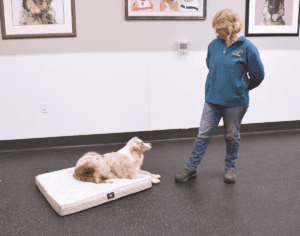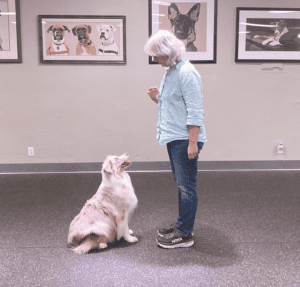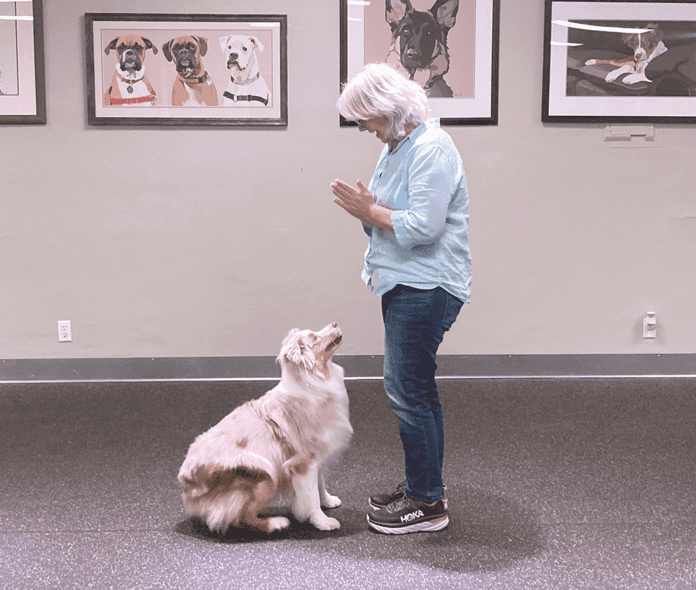Sometimes you need your dog to sit and stay in one place, such as when the doorbell rings and you need to grab the flower delivery for your birthday. Stay is one of the basic commands, or cues, for dog training, along with sit and down. Note: Dog trainers use the word “cue,” not “command,” when discussing training. The stay cue is a simple opportunity for your dog to earn delicious treats or an enjoyable game with a favorite toy, and it’s a relatively easy behavior for most dogs to learn. Here’s how to teach your dog to sit and stay or lie down and stay.
Teach How to Sit and Stay in Small Increments
The most important part of teaching your dog to do anything on cue is to teach it in small steps and set your dog up to succeed. A good stay consists of your dog remaining in place for some duration, while you are at a distance from him, even in the midst of distractions. However, we don’t attempt to teach a dog all three of these key elements – duration, distance, and distraction – all at once. Each piece is added in small increments, starting with duration, then adding distance, and finally, distraction.
Start With Duration

With your dog in either a sit or down position, say “Stay” and hold up a treat for 1 second. If he stays, mark the brief stay with the click of a clicker or a verbal marker (such as the word “Yes!”) and feed him the treat. If necessary, hold the treat right in front of his nose at first to keep him in place. If he gets up, say “Oops!” in a cheerful voice, whisk the treat behind your back, and ask him to sit again. You’ll do the cheerful “Oops!” any time he mistakenly gets up too soon. The removal of the treat helps him realize that getting up makes the reward disappear.
Cue the stay a number of times, gradually extending the length of time you have him stay by a second or two every half-dozen successful repetitions before marking and rewarding the behavior, until he’ll stay for 10 seconds or longer. Intersperse longer stays with shorter ones so it doesn’t just get progressively harder and harder for him – set him up to succeed!
After a few repetitions, stop holding up the treat when you give the verbal stay cue, so he’s holding the stay without the food lure.

Always use a release word to end the stay after several repetitions so your dog understands that the stay isn’t over until you release him. The word “Okay” is not recommended because of its common use in conversation. (Perhaps your dog is on a down-stay at the beach. You turn to your spouse and say, “Okay, let’s go to dinner tonight.” Whoops – there goes your dog! Frequently used release cues include “Free,” “All done,” “At ease,” and “Release.” You can, of course, use any word or words you want; they have no meaning to your dog until you associate them with the release.
When releasing your dog from the stay, get excited, encourage him to get up, and praise him when he does. It’s important that he actually gets up when you give the release cue, so you know he understands the stay is over.
Now Start Adding Distance

When you dog is holding a 30-second stay consistently, you can start adding distance. Ask your dog to stay (give your cue), take one step back, mark the behavior (click or “Yes!”), and return to him to feed him the treat. If his stay is solid when you take one step away, try two steps. Then three. Then step to the side. Then four steps. Then three steps to the side. Keep varying the distance and direction that you step away, so the behavior doesn’t just get progressively more difficult.
As you increase the distance that you step away from your dog, the duration of the stay will naturally increase, too. Increase the duration gradually, standing at the increased distance for longer periods before you mark and return.

If your dog starts “breaking” the stay before you return and release, you’ve asked too much. Return to a distance where he can succeed and increase the distance more slowly.
Remember to mark when you are away from your dog and return to him before you give the release cue, so he understands the stay isn’t over until you return. After you return, pause for varying lengths of time before you release, so he understands that he has to wait for you to give the release cue before getting up. If you release immediately each time, he’ll think your return is the release and won’t wait for the cue. After his stay is solid, you can also teach him that other action cues (such as “Come!”) can also work as a release.
Adding Distractions

Now the real fun begins. Once again, as you introduce something new – distractions – to your dog’s practice sessions, decrease the duration of your stay requests as well as the distance you walk away from your dog.
Start small: Stand in front of your dog, ask him to “Stay,” and jump once, slightly off the ground. If he remains in place, mark the successful behavior (click or “Yes!”) and give him a treat. Repeat until he’s solid with one jump, then gradually increase the amount of distracting movements you make. You can try jumping higher, doing two jumps, hopping on one foot, clapping your hands, getting down on all fours, bouncing a ball – the possibilities are endless! Intersperse easier challenges with increasingly difficult ones, so the challenge doesn’t become inexorably more difficult, and remember to return and use your release cue frequently.
Finally, mix up randomly changing combinations duration, distance, and distractions, always reducing these D’s if your dog is unsuccessful inholding his position until his stays are solid again.





